Innworld
More actions
Innworld, is the official[1] name of the World where The Wandering Inn takes place in. Innworld is known to other worlds because of the God War and has been called the "hegemony of gods" by another world's god.[2] This page is intended to cover all of the general information about the world and how it is different from Earth.
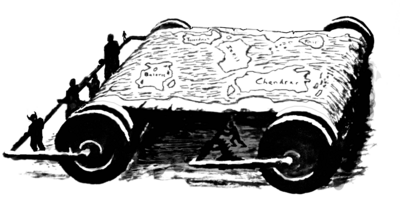
Fanwork by geoawk.
Background edit edit source
Innworld was created as a grand project between various gods and pantheons. Some of the gods were outcasts, or refugees that had lost their original world, while others abandoned their home to participate. Some entire pantheons moved to Innworld and brought their followers with them. The plan, devised by Isthekenous, was to forge a great world whose mortals could challenge the champions of other worlds. Even Oberon and the fae were allies during that era.
It took a long time for the various deities to come to a consensus, enough for lifetimes to pass and entire populations to florish. Because of the many influences from the different gods, the world was unpolished and generic in some places during its inception. It was meant to be a trial, but it proved so successful that most gods wanted to begin the project at once. This was when the God War began.[3]
The plan was to create an entire cosmos, with each God having their own planet to own and manage. But because of the God War, only the prototype world was ever built, with the stars remaining as mere lights in the sky.[4]
Classes and Skills edit edit source
Most sentient beings are able to level in what are called classes, and thus gain Skills (see here for further details). That includes many listed people of the Races page and excludes all listed entries of the Monsters page (with the exception of leveling Undead, of which the only known instances are Toren and the Chosen). This leveling system announces the accomplishments inside the mind of the leveled-up person[5] in a universal language.[6]
Physical Properties edit edit source
Inhabitants believe that Innworld is flat due to the existence of the Edge of the World.[7] That one can sail south from one end of Chandrar in a straight line and arrive on the other end of the continent is attributed by inhabitants to an unknown magical effect. Wistram's Earthers have introduced the concept of a round world to its [Mages], but the theory didn't receive wide approval, despite measurements taken by mages all around the world that indicated to the Earthers that their assumption of a round planet is correct. However, it is confirmed by one of the Gnomes that the world is spherical, and the so-called edge is the location where part of the world was torn away during the war against the gods. The world has twin moons, one blue and the other green, that wax and wane independently from each other, a single sun and either no actual equator or a weird one.[8] Solar eclipses occur at least twice a year.[9] The sun rises and sets at the same time across the planet and the seasons are the same on both hemispheres. Because it was created with the fae being welcome guests in mind, the world relies on the Winter Sprites to bring seasonal snow.[10]
The surface area of the world has been estimated by Ryoka and later other Earthers to be three times that of Earth.[11] The enormous size of the continents supports this theory: Izril, despite being considered the third-largest continent, was estimated by Ryoka to span 8000 miles from north to south,[12] which combined with its width suggests a size comparable to Eurasia
The sky is larger and vaster than Earth's The vivid blue infinity above her head [...] was different from the one she had seen all her life.[13] This suggests at least a thicker atmosphere, or some other reason why there is more air between the sun and the ground. Another difference is that - at least in Liscor's late autumn - the sun set closer to the south than the west in this world.[14]
The stars in the sky are fake and shine in various colors.[15] The stars do move as if the world is rotating. The inhabitants have designated constellations. Known constellations include: the Guiding Dragon, the Guiding Flame.[16]
Underneath the surface, vast amounts of water flows down. Gravity also lessens the deeper one goes underground. Galuc suspected that if gravity worked normally at those depths, the world would implode from the inside-out.[17]
Calendar System edit edit source
There are sixteen months to a year, with four weeks per month and eight days per week.[18][19] Despite the longer years, the inhabitants still conform to Earth's sense of time, and an eight year old in Innworld will still look like an eight year old, rather than looking older.[20]
The days are called (in order of being revealed):
- Laudas[21] - A name of a day used in Roshal, which refers to the 23rd of Solla.
- Beithday[22]
- Tirenv[23]
- Nendas[24] - The 4th day of the week.
- Saelsmorn[25] - The 2nd day of the week.
The months are called (in order of being revealed):
- Rerrk[26] - Last month of Spring
- Solla[21]
- Liuwhe[27] - The 13th month of the Year, 1st month of Winter
- Mouring[25] - The 14th month of the Year, 2nd month of Winter
- Elfebelfast[28] - The 15th month of the Year, 3rd month of Winter
The Winter Solstice takes place on the last day of Mouring. Once established, Christmas takes place on the 25th of Mouring.[27]
Continents, Racial Geography and Major Powers edit edit source
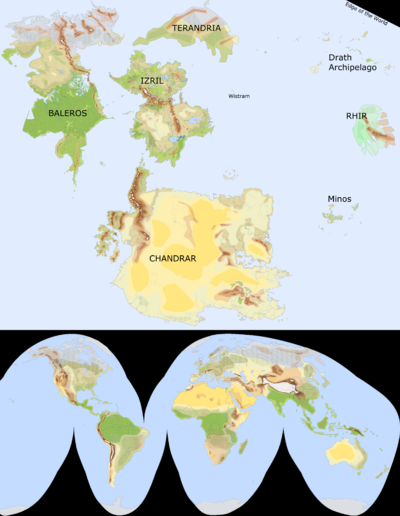
The Innworld has five continents, by the names of Terandria, Izril, Chandrar, Rhir, and Baleros. There is also a massive archipelago filled with whirlpools and deadly storms that is all that remains of the sixth continent[11], but that place has not been detailed further yet. There were originally seven continents[29], of which Drath is a remnant[30], and an apparently artificial "sixth continent" called Tiernas or the "Continent of Glass" existed at some point[31] which may have been one of those two or created and destroyed after them. There also used to be Dwarven-build bridges between the continents that have long since sunk, but beings as tall as Cyclopes can still use to walk across the seas.[32]
This section lists the major races that live on each continent, and the major powers in world politics.
Terandria edit edit source
- Humans
- Half-Elves
- Dwarves
- Lucifen (In hiding)
- Agelum (In hiding)
Humans are the vastly dominant race of Terandria, ever since they toppled the Half-Elves from their position of power several millennia ago. In many places, non-Human races are discriminated against, not only the Half-Elves. There is a plethora of large and small kingdoms and other realms there, and Knight Orders wield great powers throughout the continent. The ancient human kingdoms of Terandria maintain a solid infrastructure[33], but there is still large untamed wilderness in many places.[34]
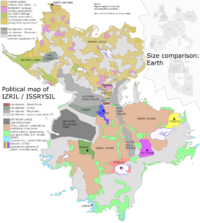
Izril edit edit source
- Drakes (Walled Cities)
- Humans
- Gnolls
- Antinium
- Vampires (In hiding)
- Unicorns (In hiding, near-extinct)
The native races, the Drakes and Gnolls mostly reside in the southern half of Izril. Drake politics are dominated by the six Walled Cities, while the Gnolls live a nomadic life in the plains or live in the cities.
The north is largely dominated by Humans, the result of a large-scale Human invasion which occurred a few millennia ago. The Five Families have historically been the major power, although they have waned in the last centuries, with currently only two scions of these families being politically prominent: Magnolia Reinhart and Tyrion Veltras.
The Antinium, being recent invaders from Rhir, are not recognized diplomatically anywhere but in Liscor. Two other powerful figures who are currently choosing to stay hidden from the open stage are Teriarch and Az’kerash.
A long time ago, Harpies ruled in the area that was later turned into the High Passes.
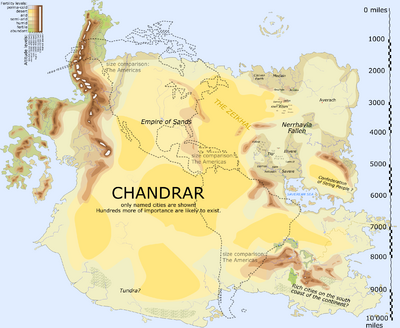
Chandrar edit edit source
- Humans
- String People
- Garuda
- Beastkin
- Djinni
- Half-Giants
- Jinni (extinct)
One of the most powerful nations in Chandrar, if not the world, is Roshal, a millennia-old and powerful economoical institution. In the past, Chandrar had many Shield Kingdoms of which only four still remain. Currently the largest and most powerful nation in Chandrar is the Empire of Sands, followed by Nerrhavia's Fallen, which both have a majority population of String-Folk. The Siren of Savere rules a naval nation that plays in the big leagues with regards to piracy. Flos Reimarch is the previous ruler of the vast continent and currently trying to reclaim his glory.
Djinni lived on Chandrar, but are all enslaved save for those that reside on Rhir. Their half-mortal kin the Jinn are extinct.
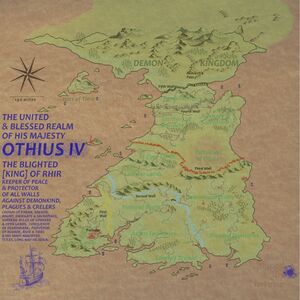
Rhir edit edit source
The three current major powers in Rhir are the Blighted Kingdom, the Demon Kingdom, and the Antinium Hives. The Blighted Kingdom and Demon Kingdom have been at war for over five thousand years. While the Blighted Kingdom is supplied by allies of almost all nations. the Demons lack public support from other known nations or groups, although some Dullahans, Drowned Folk, and Drath clandestinely trade with them. The Antinium Hives are located underground in territories adjacent to the Demon Kingdom. The Antinium are technically allied with the Demons, though their alliance is implied to be a non-aggression pact.[35]
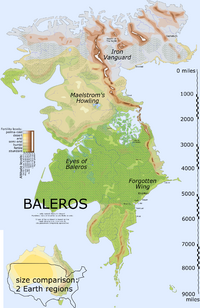
Baleros edit edit source
- Lizardfolk (Jungle Tails)
- Dullahans (Iron Vanguard)
- Centaurs (Maelstrom’s Howling)
- Humans
- Gazers (Eyes of Baleros)
- Half-Gazers
- Beastkin
- Fraerlings
- Selphids
Of the Four Great Companies of Baleros, three are listed above, since in each one, a specific race is dominant. However, other races are still hired in the companies; with the possible exception of the Eyes, about whom much is unknown. The Forgotten Wing Company is the newest and most multispecies of the Big Four, having toppled Jungle Tails a few decades ago. Hundreds of other companies fight over the rest of Baleros.
This state of affairs has been stable since time immemorial, although the number of Great Companies has varied over time.
Wistram edit edit source
Wistram Academy has fierce internal politics consists of many factions, the most powerful of which are led by the Archmages. Despite its (self-proclaimed) neutral stance of world affairs, Wistram is nonetheless considered a world power and often interferes in certain events.
Minos edit edit source
The Minotaurs prefer to live without foreign influence, which is why their islands are famous for having not many outsiders to the Minotaur race living there. They are one of the foremost naval powers, especially in their region of the sea.
Drath edit edit source
The Drath Archipelago is the remains of the sixth and/or seventh continents of the world, which was destroyed in the final blow of the God War long ago.[11] The primary political power is the Empire of Drath, which is largely isolationist.
Non-Continental or Unknown edit edit source
- Dragons (In hiding, near-extinct)
- Drowned People (Live near or in the sea)
- Elves (Extinct)
- Gnomes (Extinct)
- Goblins (All continents)
- Haflings (Extinct)
- Ogres
- Sariant Lambs (All continents)
- Trolls (All continents)
- Undead
Language edit edit source
Spoken Language edit edit source
The dominant spoken language in the world is English, which can be understood by all people that the story introduced so far (with the exception of Earthers who don't speak English). There are however other languages[36] such as the ones used by the Drathians.[37] Roshal has a language called true Roshalian, but it's only used to command slaves or as a mark of prestige.[38]
Goblins also claim their own language, which includes a significant incorporation of body language, and is especially notable for its large lexicon of words for different kinds of death. Other primitive people considered monsters such as Ogres, Gargoyles, and Dorhmin also have their own languages. Ogres are notable for using their own language to cast magic.[39]
Written Language edit edit source
Unlike in Celum in which the citizens not only speak English but also use the same writing system, which possibly goes for most other human cities,[36] in Liscor the people only speak in English while another completely different written language has been implemented.[40]
It seems that older written texts need translation, which involves for examples books older than some thousand years; and glyphs found in ancient crypts. This translation is usually done through magic.[41][42] Latin also exists as a written language, and is called the language of magic.[43]
There are no reports of any basic education system in the whole world. Yet, most people in the story seem to be able to read without issues (for example, even eremitic [Farmers] are used to exchange messages; guild jobs are posted on announcement boards; etc.). The only known persons who professed not being able to read at some point, were Garia Strongheart and Durene.
Afterlives edit edit source
There are three afterlives in Innworld: Kasignel, Hellste, and Diotria. The Land of the Dead, also known as Kasignel, is where most ghosts of people reside after their deaths. It is more or less a reflection of the real world, though it echoes multiple periods of times in history. The laws of physics do not apply, while Skills and magic are disabled.[44] Hellste is where the sinners and vile individuals are sent as punishment, as well as all Goblins who have since taken control of the realm.[45] Diotria was a reward for heroes, champions, and those with the Gods' favor. It too has changed considerably from its inception, and thanks to the actions of Emerrhain magic and skills are enabled there.[46]
Trivia edit edit source
- Krngnoll, which means The Great Land in Gnollish, is the Gnoll name for the world.[47]
- As the official name of the World is currently unknown, the readers have come to designate it as Innworld. Even Pirateaba has come to use this term as well.
- The inhabitants use the imperial system of measurement, with the exception of using grams to measure weight.[48]
References edit edit source
- ↑ 1.0 1.1 Solstice (Pt. 3)
- ↑ Chapter 8.82 (Pt. 2)
- ↑ Chapter 9.66
- ↑ 10.34 MGF
- ↑ Chapter 1.02
- ↑ Chapter 6.05 D
- ↑ Chapter 4.03 K
- ↑ Chapter 6.06 D
- ↑ Chaptetr 9.65
- ↑ 10.37 GDI (Pt. 1)
- ↑ 11.0 11.1 11.2 Chapter 2.06
- ↑ Chapter 2.08
- ↑ Chapter 1.02
- ↑ Chapter 1.28
- ↑ Chapter 9.57 B
- ↑ 10.03 Y
- ↑ Chapter 9.50
- ↑ Chapter 9.14 VM
- ↑ Chapter 9.39
- ↑ Chapter 9.40 GG
- ↑ 21.0 21.1 Chapter 8.32
- ↑ Chapter 9.01
- ↑ Chapter 9.28
- ↑ Chapter 9.38 TV (Pt. 2)
- ↑ 25.0 25.1 Interlude – Innovation and Invention
- ↑ Chapter 6.68
- ↑ 27.0 27.1 Chapter 9.41 (Pt. 1)
- ↑ Chapter 9.44 P
- ↑ Chapter 8.79
- ↑ Chapter 8.80
- ↑ Chapter 8.76 B
- ↑ 10.07
- ↑ Interlude - Talia
- ↑ Chapter 6.42 E
- ↑ Interlude - Songs and Stories
- ↑ 36.0 36.1 Interlude – 1.00 R
- ↑ Chapter 6.20 D
- ↑ Chapter 9.49
- ↑ Chapter 7.43 G
- ↑ Chapter 1.13
- ↑ Chapter 1.02 H
- ↑ Chapter 3.35
- ↑ Interlude - Death and Stitches
- ↑ Chapter 8.11 E
- ↑ Chapter 9.66
- ↑ Chapter 9.67 (Pt. 1)
- ↑ Chapter 8.66
- ↑ Chapter 9.41 (Pt. 2)